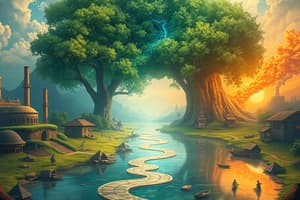Podcast
Questions and Answers
What is a major consequence of deforestation and forest fragmentation?
What is a major consequence of deforestation and forest fragmentation?
- Improved air quality
- Enhanced climate stability
- Increased biodiversity
- Disruption of ecological processes (correct)
How does rapid population growth typically impact the environment?
How does rapid population growth typically impact the environment?
- It decreases the pressure on natural resources.
- It exacerbates environmental problems. (correct)
- It encourages waste reduction.
- It reduces the need for sustainable practices.
Which conservation strategy is crucial for preserving biodiversity?
Which conservation strategy is crucial for preserving biodiversity?
- Promoting urban development
- Expanding agricultural land
- Increasing fossil fuel use
- Reducing consumption and waste generation (correct)
What is a key focus of sustainable development?
What is a key focus of sustainable development?
What strategy can help mitigate human impact on the environment?
What strategy can help mitigate human impact on the environment?
Which of the following human activities is primarily responsible for habitat loss and decreased biodiversity?
Which of the following human activities is primarily responsible for habitat loss and decreased biodiversity?
What is a significant consequence of deforestation on the environment?
What is a significant consequence of deforestation on the environment?
How does air pollution contribute to climate change?
How does air pollution contribute to climate change?
Which factor is NOT a direct result of climate change?
Which factor is NOT a direct result of climate change?
Which of the following is a consequence of overfishing?
Which of the following is a consequence of overfishing?
What major problem does pollution pose to aquatic ecosystems?
What major problem does pollution pose to aquatic ecosystems?
What impact does the loss of biodiversity have on ecosystems?
What impact does the loss of biodiversity have on ecosystems?
Which of the following scenarios represents unsustainable resource consumption?
Which of the following scenarios represents unsustainable resource consumption?
Flashcards
Deforestation impact
Deforestation impact
Disrupts ecological processes and reduces biodiversity due to loss of forests.
Overpopulation effect
Overpopulation effect
Exacerbates environmental problems by increasing resource pressure and waste generation.
Conservation Strategy
Conservation Strategy
Actions to reduce the negative impact humans have on the environment.
Sustainable Dev. Goal
Sustainable Dev. Goal
Signup and view all the flashcards
Resource Sustainability
Resource Sustainability
Signup and view all the flashcards
Human Impact on Environment
Human Impact on Environment
Signup and view all the flashcards
Pollution Types
Pollution Types
Signup and view all the flashcards
Climate Change Cause
Climate Change Cause
Signup and view all the flashcards
Resource Depletion
Resource Depletion
Signup and view all the flashcards
Biodiversity Loss
Biodiversity Loss
Signup and view all the flashcards
Ecosystem Disruption
Ecosystem Disruption
Signup and view all the flashcards
Deforestation Impact
Deforestation Impact
Signup and view all the flashcards
Population Growth Effect
Population Growth Effect
Signup and view all the flashcards
Study Notes
Human Impact on the Environment
- Humans are significantly altering the planet's ecosystems, often negatively impacting biodiversity and other life forms.
- Industrialization, agriculture, and urbanization are major contributors to environmental degradation.
- Population growth intensifies resource consumption, which leads to greater strain on natural systems.
- Deforestation, for example, reduces carbon sequestration capacity and habitat for numerous species.
Pollution
- Pollution is a widespread problem with various forms, including air, water, and soil pollution.
- Air pollution from industrial emissions and vehicles contributes to respiratory illnesses and climate change.
- Water pollution from industrial discharge and agricultural runoff harms aquatic ecosystems and human health.
- Soil pollution from pesticides and heavy metals negatively impacts plant growth and food chains.
Climate Change
- Climate change is a major concern driven by human activities like greenhouse gas emissions.
- Increased greenhouse gas concentrations lead to a rising global temperature, resulting in more frequent and intense extreme weather events.
- Rising sea levels inundate coastal zones, threatening human settlements and ecosystems.
- Changing climate patterns disrupt agricultural cycles, impacting food security in many areas.
Resource Depletion
- Unsustainable resource consumption depletes vital natural resources like forests, water, and minerals.
- Overfishing depletes fish populations and disrupts marine ecosystems.
- Overexploitation of forests for timber and agricultural land reduces biodiversity and soil fertility.
- Water scarcity is driven by overconsumption and inefficient use of water resources, particularly in arid and semi-arid regions.
Biodiversity Loss
- Human activities like habitat destruction, pollution, and climate change drastically diminish biodiversity.
- Loss of biodiversity reduces ecosystem resilience and the services they provide to humans.
- Extinctions of species lead to a decline in genetic diversity.
- Reduced biodiversity impairs ecosystem stability making them more vulnerable to shocks.
Impacts on Ecosystems
- Human activities cause considerable changes in ecosystems.
- These changes range from minor disturbances to significant disruptions of natural processes.
- Agricultural expansion results in habitat loss, causing a cascade of environmental problems.
- Deforestation and forest fragmentation disrupt ecological processes and contribute to biodiversity loss.
Overpopulation
- Rapid population growth exacerbates environmental problems.
- Increased consumption per capita intensifies resource pressure.
- Overcrowding in some urban areas can lead to unsustainable waste management.
- Limited resources necessitate more sustainable practices to meet the needs of growing populations.
Conservation Strategies
- Conservation efforts aim to mitigate the harmful effects of human impact on the environment.
- Sustainable practices and policies, like carbon capture, can help counter negative trends.
- Reducing consumption and waste generation are essential components of a sustainable future.
- Protecting fragile ecosystems, like rainforests and wetlands, can preserve biodiversity.
Sustainable Development
- Sustainable development seeks to balance human needs with environmental concerns.
- Implementing renewable energy sources promotes a more sustainable energy future.
- Strategies for reducing ecological footprint should be prioritized.
- Encouraging responsible consumption patterns is key to environmental sustainability.
Studying That Suits You
Use AI to generate personalized quizzes and flashcards to suit your learning preferences.




